I can’t be the only one whose reading of Devil in the White City resulted in a nearly instant purchase of World’s Fair 1893. I doubt the two would have made our list of board game and book pairings if I was alone. The horrors of H.H. Holmes are the sort of legend I’d rather weren’t true, but the side-by-side demi-fiction about pulling together such a massive spectacle are engaging and a worthy antidote to the muck.
Toss in the fact that I live a half-mile from an institution whose grounds were designed by the iconic Frederick Law Olmsted—landscape architect to New York’s Central Park, the famed Biltmore estate, and the 1893 Exposition—and I was drawn into the White City and all things World’s Fair.
World’s Fair 1893 is the design of J. Alex Kevern (Succulent, Daxu), published by Renegade Game Studios. Two to four players take up the role of Fair organizers, gathering exhibits and laboring to secure the finest locations for their wares in an hour or less. At its heart, World’s Fair 1893 blends a lovely area control endeavor with a fascinating set collection dynamic.
Ingression
In a hobby where hex tiles are used to construct maps of all sorts, I am strangely delighted that World’s Fair 1893 utilizes a keyhole-shaped center and several surrounding pieces to build a singular hex that serves as the game board. At the center is the iconic Ferris Wheel, developed for the fair by George Washington Gale Ferris, Jr. Around the outside a random configuration of five distinctly colored exhibition areas serve as the battleground. Each area is capable of housing a number of cards during gameplay.

On each turn, players lay one of their twenty-two supporter cubes into one of the five areas, tinkering with the balance of control. They also then collect any cards that had accumulated in the area and play Influential Figure cards. The turn ends by dealing out three new cards clockwise to the exhibition areas beginning with the emptied space.
Influential Figure cards show historical figures associated with the Fair. Each contains a bonus action of sorts that further shifts the balance of control in the exhibition areas. Some add extra supporter cubes, others move previously laid cubes. Once these cards are collected, they are always played during the following turn.
Most of the cards show an exhibit associated with one of the five area colors. The primary aim of World’s Fair 1893 is to collect card sets containing each of the unique colors and convert those cards into scoring tokens. Half or more of the endgame score derives from successful collection.
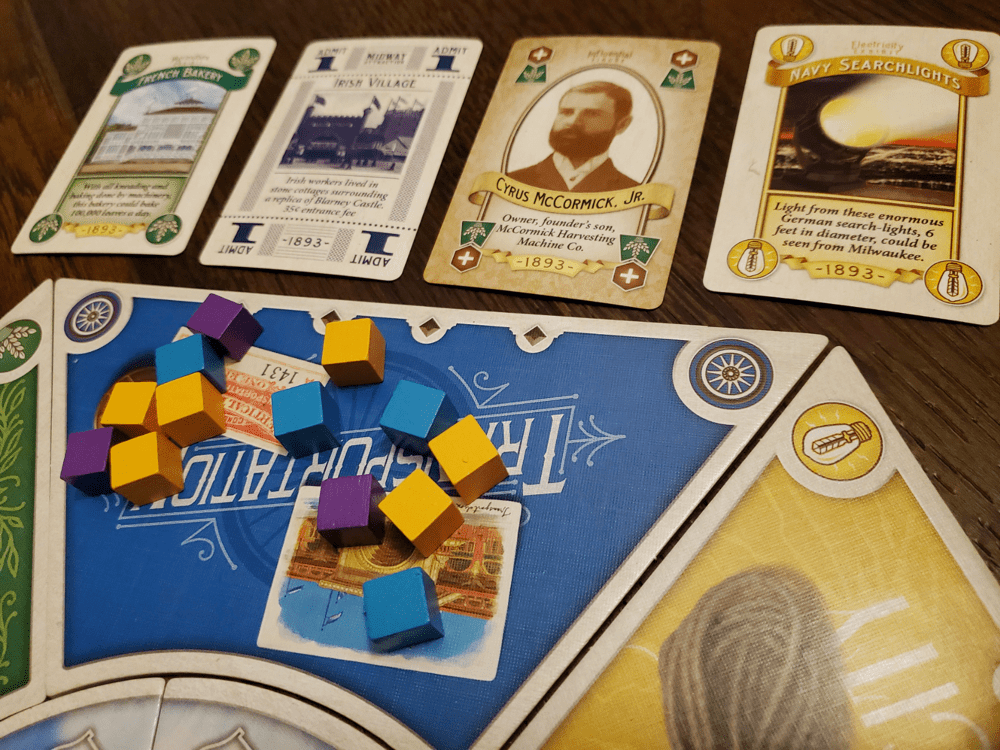
Some of the cards are Midway tickets. The Midway was a mile-long strip of attractions in the center of the Fair. For every ticket collected, the car token moves one space around the Ferris Wheel. Each complete trip around the wheel represents one of the game’s three rounds.
At the end of each round, the five areas are evaluated to determine whose exhibits will inhabit the space. Players receive point tokens based on their positioning in the area before trading their exhibit cards for matching scoring tokens. Not every ranking will score, so reaching for the top is critical. These tokens create the scoring sets at the conclusion of play. The player with the most Midway tickets also receives a bonus before the tickets are traded for a coin/point each. Once the areas are evaluated, players remove half of their supporter cubes (rounded down) from each area they occupy before play continues with the next round.
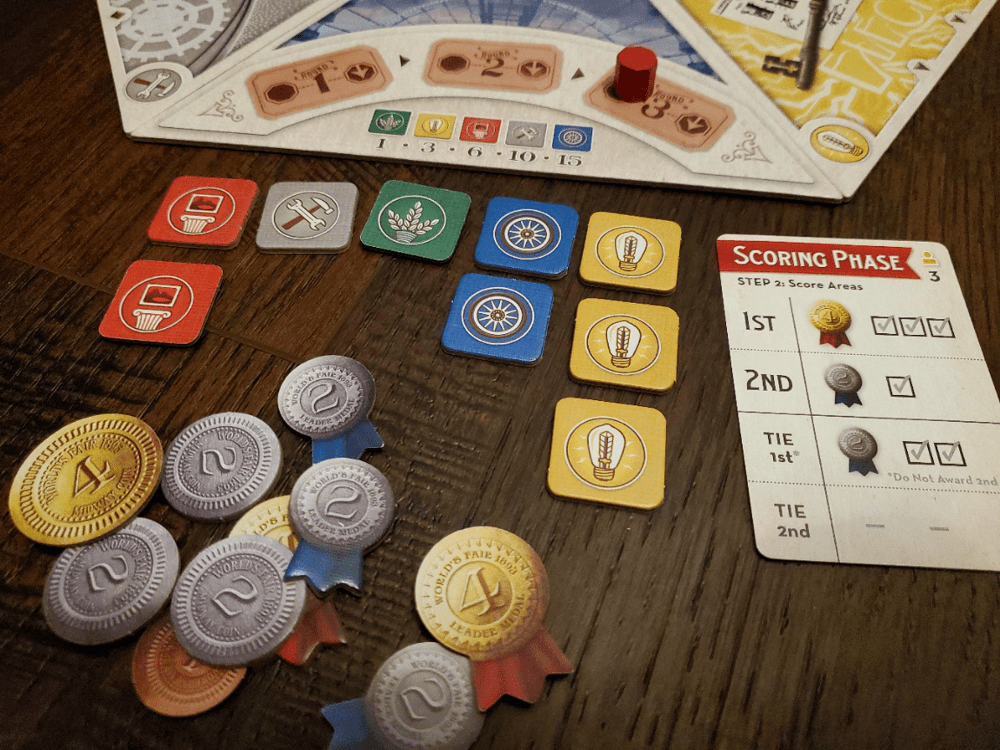
After three rounds, the final score is a combination of accumulated coins and set collection points. Players divide their exhibit tokens into sets of unique colors. Each set of all five colors is worth 15 points, four colors garner 10 points, and so on. The player who accumulates the most points is deemed the Fair Organizer extraordinaire or some similarly impressive title.
Retrogression
World’s Fair 1893 was originally released in 2016 to a mostly positive response, leading to a reprint in 2020. For this second edition, several changes sought to address the social disparities of the historical Fair while maintaining the original game experience. With regard to gameplay, the changes are seamless. With regard to historical accuracy, the changes are appreciably sensitive to the reality of life in the post-Civil War United States.
The rulebook draws attention to the pamphlet circulated during the fair with contributions from Ida Wells, Frederick Douglass, Irvine Garland Penn, and Ferdinand Lee Barnett titled The Reason Why the Colored American is not in the World’s Columbian Exposition.
Ida Wells asks the pertinent question in her Preface, addressed “To the Seeker After Truth:”
“Why are not the colored people, who constitute so large an element of the American population, and who have contributed so large a share to American greatness, more visibly present and better represented in this World’s Exposition? Why are they not taking part in the glorious celebration of the four-hundredth anniversary of the discovery of their country? Are they so dull and stupid as to feel no interest in this great event? It is to answer these questions and supply as far as possible our lack of representation at the Exposition that the Afro-American has published this volume.”
Frederick Douglass, in his Introduction, states that the answer, despite 25 years since the conclusion of national hostilities, remains slavery. He recognizes the long road toward peace is one that reaches beyond simple legislation, one that must make its greatest advances instead in the human heart. He celebrates the gains of peace and the opportunity ahead while holding nothing back regarding the injustice of his day:
“The Americans are a great and magnanimous people and this great exposition adds greatly to their honor and renown, but in the pride of their success they have cause for repentance as well as complaisance, and for shame as well as for glory, and hence we send forth this volume to be read of all men.”
Irvine Garland Penn celebrates, by name and accomplishment, advances in realms of business, literature, journalism, trades, art, sculpture, and music amid a shifting racial demographic in the United States in the late 19th century.
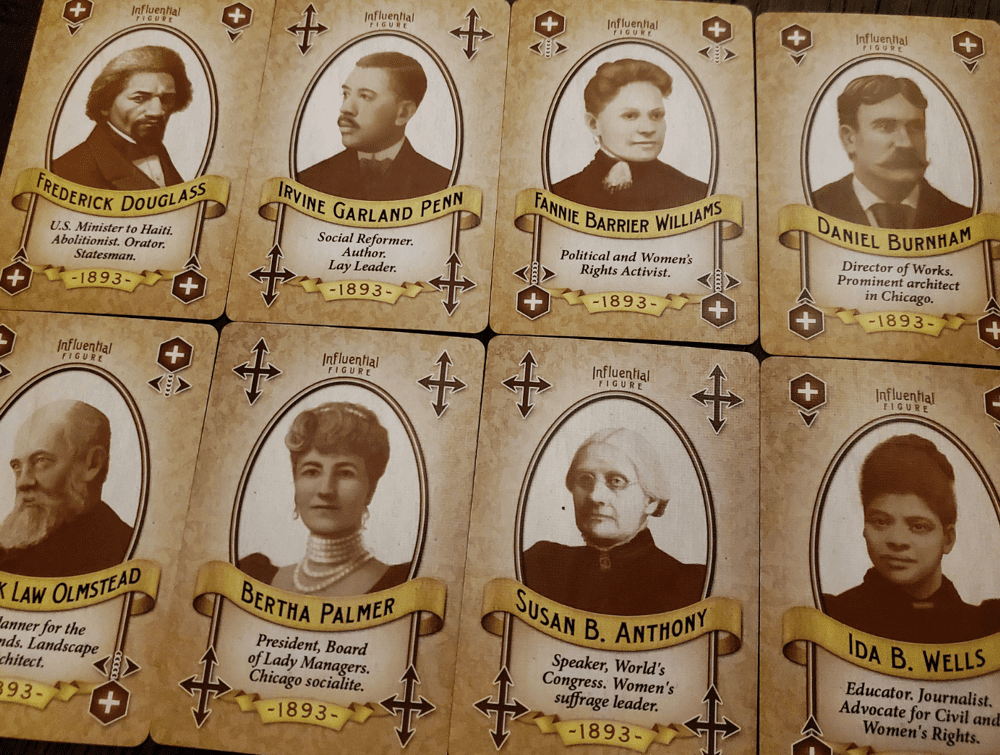
Ferdinand Lee Barnett brings the various arguments to bear on the World’s Fair, looking specifically at the six-month event and several public responses to the racial situation. He draws on public letters, creating a dialogue revealing the depth of distress and the lack of action to resolve the imbalance. His portion concludes:
“The World’s Columbian Exposition draws to a close and that which has been done is without remedy. The colored people have no vindictiveness actuating them in this presentation of their side of this question, our only desire being to tell the reason why we have no part nor lot in the Exposition. Our failure to be represented is not of our own working and we can only hope that the spirit of freedom and fair play of which some Americans so loudly boast, will so inspire the Nation that in another great National endeavor the Colored American shall not plead for a place in vain.”
I realize the scope of this section reaches far beyond the game itself, but the simple, profound changes to the game are driven by the ideas expounded in the pamphlet. The inclusion of Ida Wells, Fannie Williams, Frederick Douglass, and I.G. Penn among the Influential Figure cards alongside Daniel Burnham, Frederick Law Olmsted, and Susan B. Anthony speaks a message about the effort toward social change. As Jade R. Rogers stated in the rulebook’s concluding paragraph:
“While we celebrate the wonders of the Ferris Wheel and electric lights, let us not forget how the fair fit into the historical context of that time, and to honor those who used it as an opportunity to have their voices be heard despite the barriers.”
In a situation where the primary concern was an historical exclusion and, therefore, omission from the game, I believe the design team handled the crafting of the second edition with distinction. If I’m being honest, I miss the original cover art—Beth Sobel’s work was so inviting by comparison—but the signal of the adjustment is worth the simplification of the box to highlight the transformation within.
Progression
Perhaps the most interesting facet of World’s Fair 1893 is the way the deck suggests the movement of time. At first glance, the setting seems to be ever-so-slightly off-kilter. The game’s story puts each player in the position of a Fair organizer, gathering exhibits and pressing their influence to establish their presence in the many areas. In other words, the game takes place before the Fair. Historically speaking, the Ferris Wheel didn’t cast off its inaugural ride until one month into the Fair, yet the Wheel is marking the passage of time. Call it an extreme chronological nitpick, but it’s there.
As the game rolls on, however, the character of the deck changes as players accumulate exhibits. Every game, depending on the player count, will involve at least one reshuffle of the deck. But the composition of these subsequent decks is far different from the first run. As exhibits are scored they are returned to the deck, but this return isn’t a guarantee—cards remain laid out on the table. The reshuffled deck is often heavy on cashed Midway tickets and Influential Figures—who constantly return to the deck—hinting that the exhibits are being decided and the remaining affair is of another ilk altogether.
Is this intentional? I have no idea. At first I was annoyed that the deck was pulled out of balance by subsequent shuffles. But I’ve since grown to really enjoy the fact that the late game push revolves around the bonus exertion of influence over the areas via the Influencers in a last ditch effort to score. Additionally, the higher proportion of Midway tickets in the reshuffle means the game is likely to move at a slightly faster pace as matters roll on, almost as if the increased ticket sales mean it’s time to stop tinkering and get on with the show.
Egression
All things considered, World’s Fair 1893 is a delightful little game. We have found great enjoyment at every player count. The area control battles find their tension in the desire to win, or at least score, each of the exhibition areas at least once over the three rounds. Depending on the player count this can be quite the challenge.
From top to bottom, I love the handling of the area skirmishes. The straight push for domination via cube placement is classic. The Influential Figure cards insert a touch of superpower (and occasional nastiness) that makes every turn, every scoop of cards, important. The ability to place an extra cube in the right area, or shift a cube from one area to another, could mean the difference between victory and defeat. The desire for this power often overshadows the need for exhibit cards. This desire is given a hint of desperation as more Midway tickets are revealed in the round. J. Alex Kevern has built a masterful exercise in bearable tension.
The breakdown for scoring each exhibit area is laid out on a player aid card depending on the number at the table. I think this was beautifully handled so that, regardless of the player count, the conditions are in view of all. There are very few matters in the Fair left to question. The game is easily set up, easily taught, and easily deciphered. For a full breakdown of the box contents, check out our official unboxing (with an unexpected Meeple Mountain ancestor to boot!).
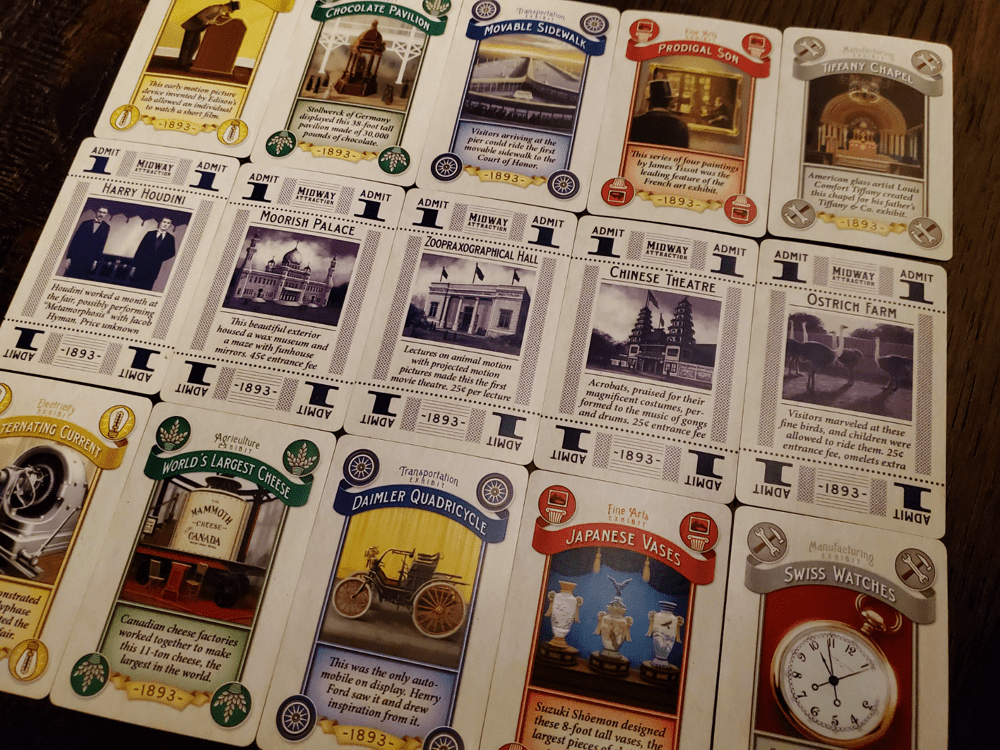
The cards are an educational wonder. Every exhibit piece is accompanied by flavor text that is never intrusive but rather always a conversation piece. In the event that someone is spending a bit too long thinking over their placement, you can raise a conversation about the Remington half dollar, the kinetoscope, ostrich rides, the 25¢ Algerian Theatre, or Hagenbeck’s Menagerie.
The setup is just variable enough to keep life interesting. The exhibit areas are never connected in quite the same way, meaning cards that involve placement in the neighboring exhibit will never quite strike the same chord. Movement across the Ferris Wheel “space” is prohibited in these cases as well, meaning there will always be that one ever-adaptable and annoying gap. Fantastic.
Overall, World’s Fair 1893 is a fun head scratcher, a game of balance, of trying to determine which iron is hot and how to transfer that heat elsewhere at the right moment. Every turn has weight, and there are always engaging moments where your preference will be stolen from under your nose and you must adapt. Thanks to the reprint, it has taken on even greater meaning in exploring the historical context and the implications of the famed White City.


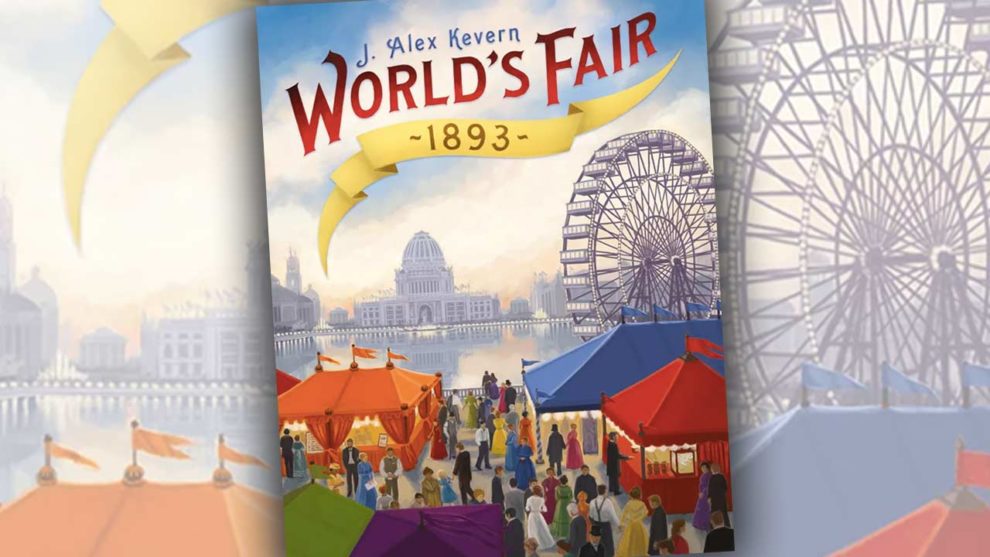









Add Comment